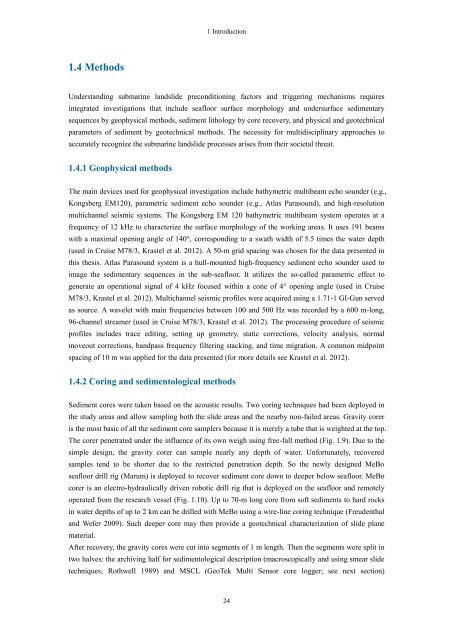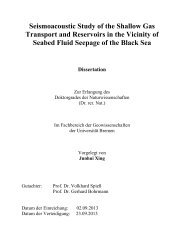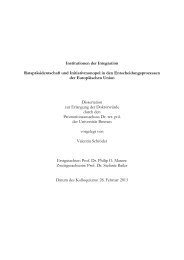Slope stability along active and passive continental margins ... - E-LIB
Slope stability along active and passive continental margins ... - E-LIB
Slope stability along active and passive continental margins ... - E-LIB
Create successful ePaper yourself
Turn your PDF publications into a flip-book with our unique Google optimized e-Paper software.
1 Introduction<br />
1.4 Methods<br />
Underst<strong>and</strong>ing submarine l<strong>and</strong>slide preconditioning factors <strong>and</strong> triggering mechanisms requires<br />
integrated investigations that include seafloor surface morphology <strong>and</strong> undersurface sedimentary<br />
sequences by geophysical methods, sediment lithology by core recovery, <strong>and</strong> physical <strong>and</strong> geotechnical<br />
parameters of sediment by geotechnical methods. The necessity for multidisciplinary approaches to<br />
accurately recognize the submarine l<strong>and</strong>slide processes arises from their societal threat.<br />
1.4.1 Geophysical methods<br />
The main devices used for geophysical investigation include bathymetric multibeam echo sounder (e.g.,<br />
Kongsberg EM120), parametric sediment echo sounder (e.g., Atlas Parasound), <strong>and</strong> high-resolution<br />
multichannel seismic systems. The Kongsberg EM 120 bathymetric multibeam system operates at a<br />
frequency of 12 kHz to characterize the surface morphology of the working areas. It uses 191 beams<br />
with a maximal opening angle of 140°, corresponding to a swath width of 5.5 times the water depth<br />
(used in Cruise M78/3, Krastel et al. 2012). A 50-m grid spacing was chosen for the data presented in<br />
this thesis. Atlas Parasound system is a hull-mounted high-frequency sediment echo sounder used to<br />
image the sedimentary sequences in the sub-seafloor. It utilizes the so-called parametric effect to<br />
generate an operational signal of 4 kHz focused within a cone of 4°opening angle (used in Cruise<br />
M78/3, Krastel et al. 2012). Multichannel seismic profiles were acquired using a 1.71-1 GI-Gun served<br />
as source. A wavelet with main frequencies between 100 <strong>and</strong> 500 Hz was recorded by a 600 m-long,<br />
96-channel streamer (used in Cruise M78/3, Krastel et al. 2012). The processing procedure of seismic<br />
profiles includes trace editing, setting up geometry, static corrections, velocity analysis, normal<br />
moveout corrections, b<strong>and</strong>pass frequency filtering stacking, <strong>and</strong> time migration. A common midpoint<br />
spacing of 10 m was applied for the data presented (for more details see Krastel et al. 2012).<br />
1.4.2 Coring <strong>and</strong> sedimentological methods<br />
Sediment cores were taken based on the acoustic results. Two coring techniques had been deployed in<br />
the study areas <strong>and</strong> allow sampling both the slide areas <strong>and</strong> the nearby non-failed areas. Gravity corer<br />
is the most basic of all the sediment core samplers because it is merely a tube that is weighted at the top.<br />
The corer penetrated under the influence of its own weigh using free-fall method (Fig. 1.9). Due to the<br />
simple design, the gravity corer can sample nearly any depth of water. Unfortunately, recovered<br />
samples tend to be shorter due to the restricted penetration depth. So the newly designed MeBo<br />
seafloor drill rig (Marum) is deployed to recover sediment core down to deeper below seafloor. MeBo<br />
corer is an electro-hydraulically driven robotic drill rig that is deployed on the seafloor <strong>and</strong> remotely<br />
operated from the research vessel (Fig. 1.10). Up to 70-m long core from soft sediments to hard rocks<br />
in water depths of up to 2 km can be drilled with MeBo using a wire-line coring technique (Freudenthal<br />
<strong>and</strong> Wefer 2009). Such deeper core may then provide a geotechnical characterization of slide plane<br />
material.<br />
After recovery, the gravity cores were cut into segments of 1 m length. Then the segments were split in<br />
two halves: the archiving half for sedimentological description (macroscopically <strong>and</strong> using smear slide<br />
techniques; Rothwell 1989) <strong>and</strong> MSCL (GeoTek Multi Sensor core logger; see next section)<br />
24
















